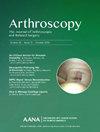与生理盐水对照组相比,微碎屑脂肪组织注射液可在一年的随访期间减轻无症状膝骨关节炎患者的疼痛:一项随机对照试验。
IF 4.4
1区 医学
Q1 ORTHOPEDICS
Arthroscopy-The Journal of Arthroscopic and Related Surgery
Pub Date : 2025-02-01
DOI:10.1016/j.arthro.2024.08.037
引用次数: 0
摘要
目的:在一项为期 1 年的随机对照临床试验中,评估微碎屑脂肪组织(MFAT)在缓解膝关节 OA 疼痛和改善关节功能方面的效果:根据基线疼痛程度对 75 名患者进行分层,并随机分为三个治疗组:注射 MFAT、皮质类固醇 (CS) 或生理盐水对照 (C)。患者年龄在 18 岁或以上,确诊为无症状膝关节骨性关节炎,膝关节骨性关节炎有放射学证据,视觉模拟疼痛量表(VAS)评分在 3/10 或以上。曾进行过膝关节内注射、目前膝关节韧带不稳定或对利多卡因/皮质类固醇过敏的患者除外。术前、2周、6周、3个月和6个月以及1年的随访中记录了VAS疼痛量表、西安大略和麦克马斯特大学骨关节炎指数(WOMAC)以及膝关节损伤和骨关节炎结果评分(KOOS):MFAT与C相比,在关节疼痛和功能方面的所有主要结果指标上都有一致且具有统计学意义的改善。对于MFAT,每次随访都比基线有显著改善,KOOS疼痛评分的中位数(95% CI)变化从第2周的18.1(11.1,26.4)到1年时的27.8(19.4,37.5)。对于 CS,KOOS 疼痛评分的中位数在第 2 周达到最高值 22.2(15.3,30.6),但在 1 年后降至 13.9(-2.8,29.2),与基线无统计学差异。C 的中位变化徘徊在 6-11 点之间,与基线相比有统计学意义的显著改善表明存在安慰剂效应。WOMAC疼痛评分和VAS疼痛评分也有类似趋势:在这项研究中,与生理盐水对照组相比,MFAT 在主要结果评分方面有显著的临床改善,而与对照组相比,皮质类固醇组仅在 2 周和 6 周时有统计学意义上的显著改善。这一结果表明,MFAT 可能是骨科治疗空白领域膝关节 OA 患者的一种可行的替代治疗方法。本文章由计算机程序翻译,如有差异,请以英文原文为准。
Microfragmented Adipose Tissue Injection Reduced Pain Compared With a Saline Control Among Patients With Symptomatic Osteoarthritis of the Knee During 1-Year Follow-Up: A Randomized Controlled Trial
Purpose
To evaluate the effectiveness of microfragmented adipose tissue (MFAT) for pain relief and improved joint functionality in osteoarthritis (OA) of the knee in a randomized controlled clinical trial with 1-year follow-up.
Methods
Seventy-five patients were stratified by baseline pain level and randomized to 1 of 3 treatment groups: MFAT, corticosteroid (CS), or saline control (C) injection. Patients 18 years of age or older, diagnosed with symptomatic OA of the knee, with radiographic evidence of OA of the knee and a visual analog pain scale score of 3 of 10 or greater were included. Patients were excluded if they had any previous intra-articular knee injection, current knee ligamentous instability, or an allergy to lidocaine/corticosteroid. The visual analog pain scale, Western Ontario and McMaster Universities Osteoarthritis Index, and the Knee Injury and Osteoarthritis Outcome score (KOOS) were recorded preprocedure and at 2 weeks, 6 weeks, 3 and 6 months, and 1-year follow-up.
Results
MFAT demonstrated consistent and statistically significant improvements across all primary outcome measures for joint pain and functionality compared with C. For MFAT, there was a significant improvement over baseline at each follow-up, with median (95% confidence interval) KOOS Pain score changes of 18.1 (11.1-26.4) at week 2 to 27.8 (19.4-37.5) at 1 year. For CS, the median KOOS pain score reached a maximum of 22.2 (15.3-30.6) at week 2, only to level off to 13.9 (–2.8 to 29.2), a level not statistically different from baseline, at 1 year. The median changes for C hovered around 6 to 11 points, with statistically significant improvements over baseline indicating a placebo effect. Similar trends were seen for the Western Ontario and McMaster Universities Osteoarthritis Index Pain score and VAS Pain score.
Conclusions
In this study, MFAT demonstrated a clinically significant improvement in primary outcome scores compared with the C group, whereas the CS group only showed statistically significant improvement compared with the C group at 2 and 6 weeks. This finding indicates that MFAT may be a viable alternative treatment for patients with OA of the knee who fall into the orthopaedic treatment gap.
Level of Evidence
Level II, partially blinded, randomized controlled clinical trial.
求助全文
通过发布文献求助,成功后即可免费获取论文全文。
去求助
来源期刊
CiteScore
9.30
自引率
17.00%
发文量
555
审稿时长
58 days
期刊介绍:
Nowhere is minimally invasive surgery explained better than in Arthroscopy, the leading peer-reviewed journal in the field. Every issue enables you to put into perspective the usefulness of the various emerging arthroscopic techniques. The advantages and disadvantages of these methods -- along with their applications in various situations -- are discussed in relation to their efficiency, efficacy and cost benefit. As a special incentive, paid subscribers also receive access to the journal expanded website.

 求助内容:
求助内容: 应助结果提醒方式:
应助结果提醒方式:


